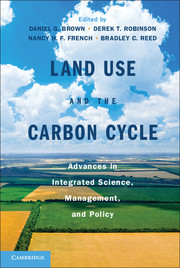Book contents
- Frontmatter
- Contents
- Chapter Authors and Affiliations
- Acknowledgments
- Acronyms
- Part I Introduction
- Part II Measurement and Modeling
- Part III Integrated Science and Research Applications
- Part IV Land Policy, Management, and the Carbon Cycle
- Part V Synthesis and Future Directions
- 20 Forests, Carbon, and the Global Environment: New Directions in Research
- 21 Ecosystem Sustainability through Strategies of Integrated Carbon and Land-Use Management
- 22 Perspectives on Land-Change Science and Carbon Management
- Index
- Plate Section
- References
22 - Perspectives on Land-Change Science and Carbon Management
Published online by Cambridge University Press: 05 February 2013
- Frontmatter
- Contents
- Chapter Authors and Affiliations
- Acknowledgments
- Acronyms
- Part I Introduction
- Part II Measurement and Modeling
- Part III Integrated Science and Research Applications
- Part IV Land Policy, Management, and the Carbon Cycle
- Part V Synthesis and Future Directions
- 20 Forests, Carbon, and the Global Environment: New Directions in Research
- 21 Ecosystem Sustainability through Strategies of Integrated Carbon and Land-Use Management
- 22 Perspectives on Land-Change Science and Carbon Management
- Index
- Plate Section
- References
Summary
Introduction
In response to the need to understand the drivers, processes, and consequences of human activities that change the land surface, the developing science of land change is addressing observations, explanations, and predictions of these land-surface changes (Gutman et al. 2004; Rindfuss et al. 2004; Turner, Lambin, and Reenberg 2007). In that context, this volume synthesizes recent advances from multiple disciplines that contribute to our understanding of how land changes affect the cycling of carbon (C) between the land surface and the atmosphere. Observations about changes in C stocks and fluxes on land and in the atmosphere, and about the contributions of the former to the latter (see Sections I and II of this volume), have played a role in motivating a wide range of economic, political, and social responses to the problem of increasing atmospheric C concentrations (see Sections IV and V). Many of the most important approaches to mitigating these increases have to do with the technological, behavioral, and regulatory innovations regarding C emissions from the use of fossil fuels. However, the secondary role of land-use and land-cover change (LUCC) and land management in causing increases in atmospheric C, as well as the potential to direct these activities toward enhanced sequestration (referred to as biological sequestration), justify attention to land-related policies and management that can respond to these challenges and opportunities. Analyses of these management and policy options are informed by both the observations that undergird our understanding of C stocks and fluxes and by results from mathematical, statistical, and computational models that encode our understanding of land-system processes and their impacts on land-based C.
What we hope to have advanced by bringing together the work presented in this volume is an integrated, interdisciplinary, cross-sectoral, and cross-scale perspective on the issues surrounding land-related C. This understanding comes from advances in the theoretical and empirical bases of land-change and C cycle sciences, as well as cross-fertilization among them. Integrating these sciences brings findings from several scientific disciplines into closer alignment with the needs of decision makers in various settings and informs those decisions in ways that consider the physical, biological, and social contexts of multiple land-related decisions. Included within these pages are numerous examples of (1) results from measurements and models of land–C interactions and (2) implications of these results for land management and policy for affecting C stocks and fluxes.
- Type
- Chapter
- Information
- Land Use and the Carbon CycleAdvances in Integrated Science, Management, and Policy, pp. 539 - 548Publisher: Cambridge University PressPrint publication year: 2013
References
- 1
- Cited by



